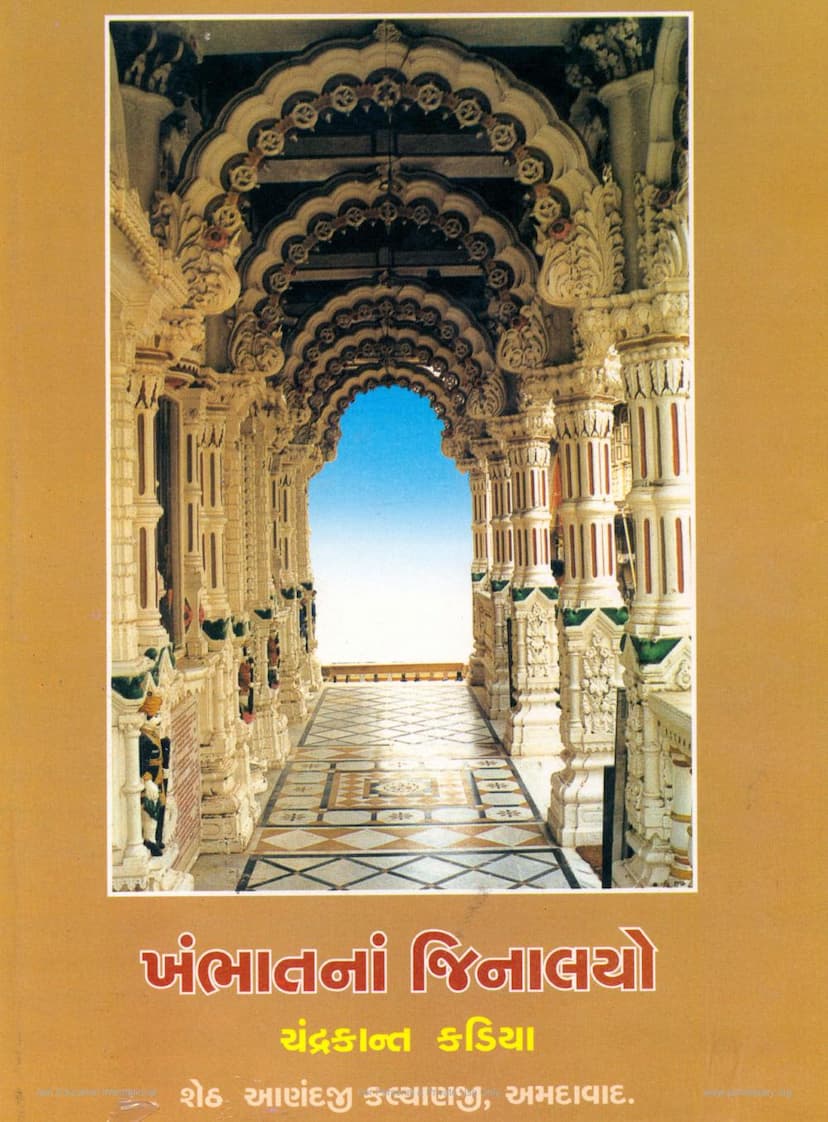Khambhatna Jinalayo
Added to library: September 2, 2025

Summary
Here's a comprehensive summary of the Jain text "Khambhatna Jinalayo" by Chandrakant Kadia:
Title: Khambhatna Jinalayo (The Jain Temples of Khambhat) Author: Chandraknart Kadia Publisher: Anandji Kalyanji Pedhi, Ahmedabad Publication Date: February 21, 2000 (Veer Samvat: 2526, Vikram Samvat: 2056) Edition: First Edition Print Run: 3000 copies
Overview:
This book, "Khambhatna Jinalayo," is a meticulous historical and architectural documentation of the Jain temples (Jinalayas) in Khambhat (also known as Stambhanpur or Cambay), a historically significant port city in Gujarat, India. Published by the esteemed Anandji Kalyanji Pedhi, the book aims to preserve the rich heritage of Jainism in Khambhat by detailing its numerous temples, their history, architectural features, important idols (Jinbimbas), and the cultural significance of the Jain community in the city. The author, Chandrakant Kadia, along with his collaborators, has undertaken extensive research, relying on ancient manuscripts, historical texts, and personal observations to compile this comprehensive work.
Key Themes and Content:
-
Historical Significance of Khambhat: The book begins by highlighting Khambhat's importance as a ancient trading port and a prominent center of Jainism. It mentions various historical names for the city, such as Stambhatirth, Stambhan, Khambhanayari, and others. The contribution of Jain merchants and patrons to the city's prosperity and the flourishing of Jainism is emphasized.
-
Perpetual Temple Construction: The text notes the continuous tradition of building and renovating Jain temples over centuries, driven by the teachings of influential Jain Acharyas and the generous spirit of wealthy patrons. The artistry of Sompura architects in sculpting marble and other stones for divine and grand idols is praised.
-
Preservation of Heritage: The book addresses the challenges faced by Jain temples due to the passage of time, political changes, and invasions, which led to destruction, dilapidation, or relocation of some temples. However, it also highlights the Jain community's efforts to protect and restore these sacred sites. The scriptural emphasis on the merit gained from renovating old temples, often exceeding that of building new ones, is mentioned as a driving force for preservation.
-
Detailed Temple Descriptions: A significant portion of the book is dedicated to providing detailed information about each temple in Khambhat. This includes:
- Location and Area: Identifying the specific locality or "pol" (neighborhood) where the temple is situated.
- Main Deity (Mulnayak): Identifying the principal idol in the temple and its approximate dating, often based on inscriptions.
- Architecture: Describing the architectural style, construction materials (marble, stone, wood, glass), structural elements (shikhara, rangamandap, torana), and unique features like carvings, sculptures, and paintings.
- Idols and Sculptures: Cataloging the number and type of idols, including Jain Tirthankaras, Yakshas, Yakshinis, and other deities. Special attention is given to the craftsmanship and artistic value of these sculptures.
- Inscriptions and Manuscripts: Mentioning and often quoting or analyzing ancient inscriptions found in temples, and referencing historical texts like "Chaitya Paripati" (descriptions of temples) and "Tirthamala" to reconstruct the history of the temples.
- Historical Context: Connecting the construction or renovation of temples to specific historical periods, rulers, ministers, and prominent Jain patrons.
- Lost Temples: Documenting temples that no longer exist but are known from historical records.
-
Chronological and Iconographic Data: The book presents tables and lists that chronologically track the number of temples over different centuries and categorize temples based on the primary Tirthankara. It also analyzes inscriptions on idols to determine their age and provenance.
-
Significant Acharyas and Patrons: The text frequently mentions the influence of prominent Jain Acharyas like Shri Hemchandracharya, Shri Abhaydevsuri, and Shri Hiravijaysurishvarji, as well as influential lay patrons like Minister Udayan Mehta and Kaveshwar Rishabhdas, highlighting their contributions to the Jain heritage in Khambhat.
-
Cultural and Social Aspects: The book touches upon the Jain community's devotion, their practice of religious rituals (Poushadhshala, Samayika, Pratikraman), their philanthropic activities, and their central role in the city's economic and social fabric. The enduring traditions, such as community involvement in temple maintenance and the spirit of devotion, are described as vital for preserving the Jain legacy.
-
Detailed Area-wise Analysis: The temples are systematically organized and described based on their geographical locations within Khambhat, such as Kharwada, Chowksi ni Pol, Bor Pipalo, Mandvi ni Pol, Jiralapada, Gimgati, Naliyera Pado, and others. This organized approach makes it easier for readers and researchers to navigate the information.
-
Appendices: The book includes valuable appendices containing:
- Lists of temples from various historical periods.
- Chronology of Jain events in Khambhat.
- Transcriptions and analyses of ancient Chaitya Paripatis and Shilalekhs (inscriptions).
- Photographs of many temples, showcasing their architectural beauty and intricate carvings.
Methodology:
The author's research methodology involved extensive study of historical Jain literature, including ancient manuscripts from various Jain knowledge repositories (Gnana Bhandars), temple inscriptions, and scholarly works. Direct field visits and discussions with local community members and temple administrators were also crucial in gathering up-to-date information.
Significance:
"Khambhatna Jinalayo" serves as a vital resource for scholars, researchers, and Jain devotees interested in the history, architecture, and religious traditions of Jainism in Khambhat. It not only documents the physical structures of the temples but also provides insights into the socio-religious history of the Jain community in this ancient city. The book underscores the importance of preserving such invaluable heritage for future generations.
In essence, this book is a comprehensive and authoritative guide to the Jain temples of Khambhat, offering a deep dive into their historical, architectural, and spiritual dimensions.